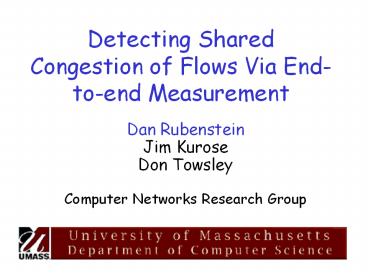Detecting Shared Congestion of Flows Via End-to-end Measurement - PowerPoint PPT Presentation
1 / 15
Title:
Detecting Shared Congestion of Flows Via End-to-end Measurement
Description:
When flows share common point of congestion (POC), bandwidth can be ' ... 20 pps. 20 pps. 2nd Simulation Setup. Co-located senders: Independent POCs. TCP traffic ... – PowerPoint PPT presentation
Number of Views:16
Avg rating:3.0/5.0
Title: Detecting Shared Congestion of Flows Via End-to-end Measurement
1
Detecting Shared Congestion of Flows Via
End-to-end Measurement
- Dan Rubenstein
- Jim Kurose
- Don Towsley
- Computer Networks Research Group
2
Motivation
- When flows share common point of congestion
(POC), bandwidth can be transferred between
flows w/o impacting other traffic
- Applications WWW servers, multi-flow
(multi-media) sessions, multi-sender multicast - Can limit transfer to flows w/ identical e2e
data paths Balak99 - ensures flows have common bottleneck
- but limits applicability
3
Detecting Shared POCs
- Q Can we identify whether two flows share the
same Point of Congestion (POC)?
- Network Assumptions
- routers use FIFO forwarding
- The two flows POCs are either all shared or all
separate
4
Techniques for detecting shared POCs
- Requirement flows senders or receivers are
co-located
co-located senders
co-located receivers
- Packet ordering through a potential SPOC same as
that at the co-located end-system - Good SPOC candidates
5
Simple Queueing Models of POCs for two flows
Separate POCs
A Shared POC
FG Flow 1
FG Flow 2
FG Flow 1
FG Flow 2
BG
BG
BG
6
Approach (High level)
- Idea Packets passing through same POC close in
time experience loss and delay correlations
Moon98, Yajnik99 - Using either loss or delay statistics, compute
two measures of correlation - Mc cross-measure (correlation between flows)
- Ma auto-measure (correlation within a flow)
- such that
- if Mc lt Ma then infer POCs are separate
- else Mc gt Ma and infer POCs are shared
7
The Correlation Statistics...
i-4
- Loss-Corr for co-located senders
- Mc Pr(Lost(i) Lost(i-1))
- Ma Pr(Lost(i) Lost(prev(i)))
- Loss-Corr for co-located receivers in paper
(complicated)
i-3
Flow 1 pkts
i-2
time
i-1
Flow 2 pkts
i
- Delay Either co-located topology
- Mc C(Delay(i), Delay(i-1))
- Ma C(Delay(i), Delay(prev(i))
i1
8
Intuition Why the comparison works
- Recall Pkts closer together exhibit higher
correlation - ETarr(i-1, i) lt ETarr(prev(i), i)
- On avg, i more correlated with i-1 than with
prev(i) - True for many distributions, e.g.,
- deterministic, any
- poisson, poisson
- Rest of talk assume poisson, poisson
Tarr(prev(i), i)
Tarr(i-1, i)
9
Analytical Results
- As samples
- Loss-Correlation technique
- Assume POC(s) are MM/M/1/K queues
- Thm Co-located senders, then Mc gt Ma iff flows
share POCs - co-located receivers Mc gt Ma iff flows share
POCs shown via extensive tests using recursive
solutions of Mc and Ma
- Delay-Correlation technique Assume POC(s) are
MG/G/1/ queues - Thm Both co-located topologies Mc gt Ma iff
flows share POCs
10
Simulation Setup
- Co-located senders Shared POCs
on/off sources
R1
30ms
TCP traffic
20ms
20 pps
30ms
S1
10ms
30ms
10ms
1000 Mbs
S2
20 pps
20ms
1.5 Mbs
R2
20ms
11
2nd Simulation Setup
- Co-located senders Independent POCs
on/off sources
TCP traffic
R1
30ms
20ms
20pps
30ms
S1
10ms
30ms
10ms
1.5 Mbs
S2
20pps
20ms
1000 Mbs
R2
20ms
on/off sources
TCP traffic
12
Simulation results
Independent POCs
Shared POCs
- Delay-corr an order of magnitude faster than
loss-corr - The Shared loss-corr dip bias due to delayed Mc
samples - Similar results on co-located receiver topology
simulations
13
Internet Experiments
- Goal Verify techniques using real Internet
traces - Experimental Setup
- Choose topologies where POC status (shared or
unshared) - Use traceroute to assess shared links and
approximate per-link delays
264 ms
UMass
30 ms
UCL
ACIRI
193 ms
Separate POCs (?)
14
Experimental Results
15
Summary
- E2E Shared-POC detecting techniques
- Delay-based techniques more accurate, take less
time (order of magnitude) - Future Directions
- Experiment with non-Poisson foreground traffic
- Focus on making techniques more practical (e.g.,
Byers _at_ BU CS for recent TR)































